How is the reproduction of violets (saintpaulia) from a leaf carried out?

When buying new varieties of violets, or working with a home flower that has sockets, the question arises of how to root cuttings and grow a new plant from a leaf. Violet lends itself easily to all these manipulations, even if the chosen material was not entirely suitable.
Cuttings (leaves, peduncles, stepchildren) stand out from each part of Saintpaulia, rooting in several ways, described in detail in this article.
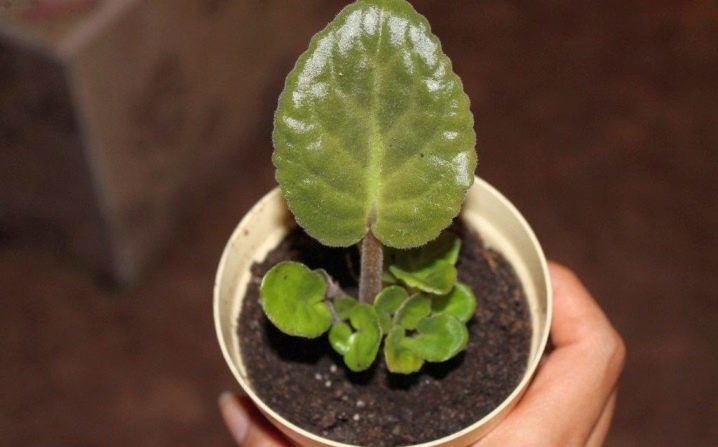
How to choose a sheet?
The familiar indoor violet is actually a saintpaulia (saintpaulia belongs to the Gesneriaceae family, and violets belong to the violet family), and further in the article, for ease of understanding, this culture will be called by the familiar name violet.
Reproduction of the plant does not cause difficulties and is calmly used at home. In the spring months, there is an active growing season for violets. In an adult culture, leaves are cut with a petiole up to 5 cm in length. The leaf plates are selected in the area of the rosettes of the second and third rows, located under the peduncles. At the same time, there are no mechanical damages and other defects on the selected shoot, the leaf is durable, juicy, saturated with a green hue. If necessary, the length of the stem of the cutting can be shortened by an oblique cut. The finished shoot is left in the air for 20 minutes so that the cut is covered with a film.
Young, old and leaves located at the edges of the plant are unsuitable for propagation by cuttings. And also do not choose sheet plates from the center of the outlet.
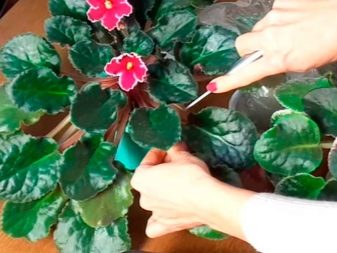
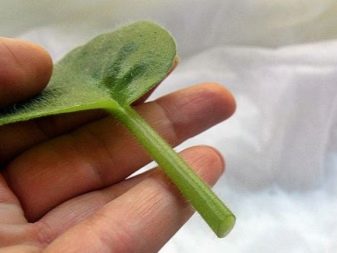
When rooting, growth stimulants and other drugs are not used, since they can cause a burn on the cut section of the cutting and lead to rotting of the fragment.
How to root?
Rooting of the cuttings can be done at home. The number of established shoots depends on the conditions created. Cutting takes place using a leaf or part of a plant, and flowers and seeds can also be used to propagate violets.
To take root with a handle, you should choose one of the methods.
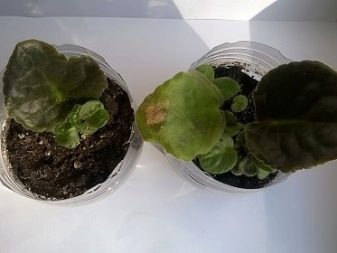

In water
The rooting process in water is the simplest and fastest way, but it does not give 100% results. The prepared segment can sleep for a long time, being in a liquid, or it is difficult to grow roots if the formed callus is damaged.
A violet leaf should be placed in a pre-sterilized glass jar with boiled water. The transparent material will allow you to monitor the state of the cutting, the formation of rot or mucus, the formation of roots, and also prevent the formation of algae on the walls of the container.
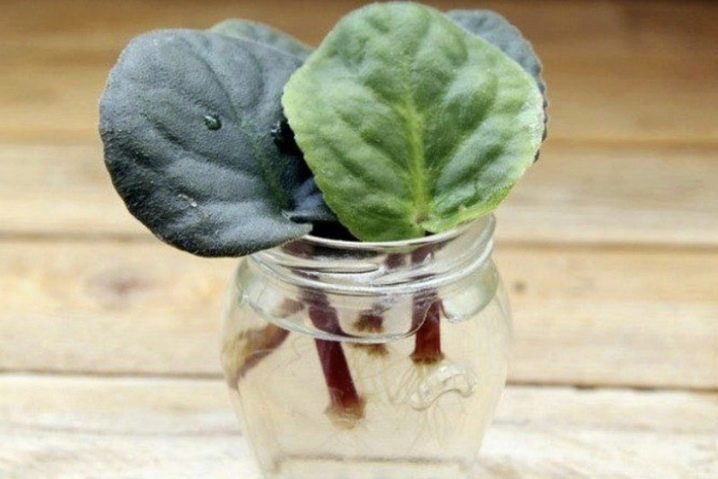
The step-by-step instructions include a number of steps.
- On the mother plant, choose a suitable leaf and cut off the future stalk.
- Place the prepared shoot in a jar, while it should not touch the bottom of the dish. The fragment is placed on punch-hole paper or with sticks.
- To prevent the occurrence of pathogenic bacteria, an activated carbon tablet is diluted in the water.
- As the liquid evaporates, clean boiled water is added to the jar.
- The liquid level should not come into contact with the cutting leaf plate and should remain at its original value.
- At the end of the cutting, a callus should form - a place from which new roots will grow in the future. This area cannot be wiped with hands or dried.
When the root system reaches 1-2 cm in length, or a rosette begins to form on the shoot, the cutting is ready to be planted in the potting mix.
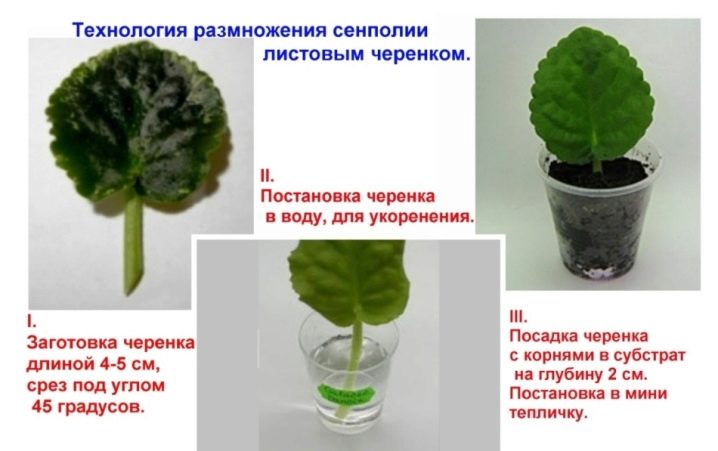
In the ground
Rooting of the cuttings can also take place in the substrate.
- Cut off a leaf from a healthy plant with a leg 3-4 cm long and a leaf size of at least 3 cm. Dry the resulting fragment in the fresh air, cut the leg with charcoal.
- Plant the finished cutting in a container with prepared soil at an angle of 45 degrees to a depth of 1-2 cm. The soil must first be moistened.
- From above, the plant is covered with another dish or bag to create a greenhouse. The container with the plant is placed on a bowl or tray of a flower pot. Through this container, the cutting will be watered with warm filtered water.
- Holes must be made in the greenhouse to drain excess condensate.
- The young plant is placed in a warm, light place.
- With successful rooting, young leaves and a rosette will appear on the handle. In this case, the violet is ready to be planted in a permanent pot.
- Propagation of stepchildren or flower stalks of Saintpaulia should be in the soil mixture.
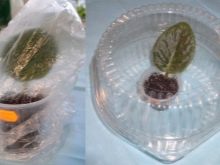
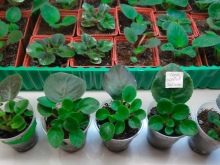

How to plant in a pot?
When transplanting, it is forbidden to affect the root system of a young culture. It is recommended to completely pull the stalk out of the temporary container with a lump of earth and plant it in the finished moist soil with a dug hole. The width and depth of the planting pit is equal to the size of the previous pot.
If several daughter outlets are formed at the rooting site, each of them should be transplanted in turn. The emergence of a large number of children occurs when choosing a strong cutting. Each future rosette should grow at least 2 leaves and grow to 2-5 cm in diameter. Only after that, it is possible to carry out the procedure for separating daughter plants from the cuttings, followed by planting in the ground.
Consider a way to separate the baby. On the mother's cutting, using a sharp knife, cut off the baby with the roots that have formed and transplant it into a ready-made container with loose soil. The rest of the processes are cut off as they develop.
When transplanting, do not deepen the growth point of the plant. After a month or more, the rosette of the young violet should exceed the size of the container, after which it is transplanted into a new pot.
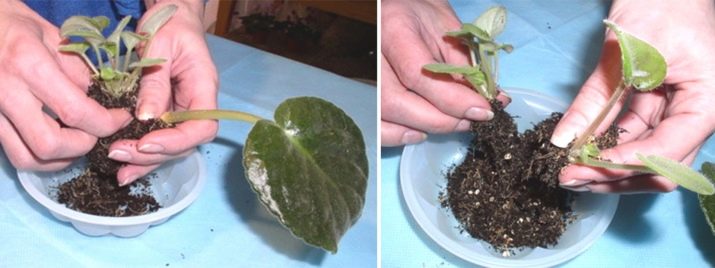
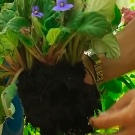
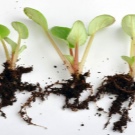
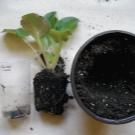
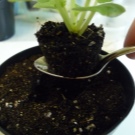
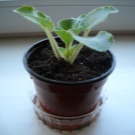
How to propagate?
Saintpaulia leaf, in whatever state it is (freezing, rotting, torn in half), is suitable for the reproduction of violets. In the process of breeding, the entire leaf plate is used, with a handle (stem) or part of it. It is important that the veins from which the future rosette of the flower is formed are preserved on the leaf, but, as a rule, plants obtained in this way are small in size, inhibited in growth, and they are also slightly weaker than crops obtained by other methods.
To propagate a violet using a cutting, the rooting methods using water or soil described above are used.
With the help of stepchildren
This method is used when it is not possible to root a whole stalk, or when buying rare and other varieties by mail.
If the substrate contains a large amount of nitrogen, small processes are formed in the axils of the leaf plates of Saintpaulia - stepchildren or daughter rosettes. Stepsons are used to reproduce violets by separating the parent from the plant, preserving 4-5 leaves on the shoot. Rooting of the stepson takes place in moist, loose soil with the addition of sphagnum moss in a container with a lid or in one on which you can put a plastic bag or plastic bottle.
After the rooting process (the shoot will start to grow), the young plant must be transplanted to a permanent place in a small pot. The duration of the rooting of a stepson is on average 2 months.
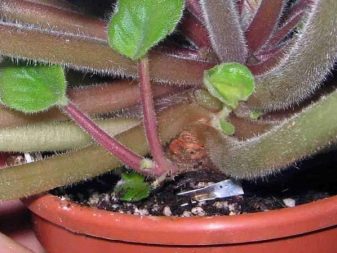
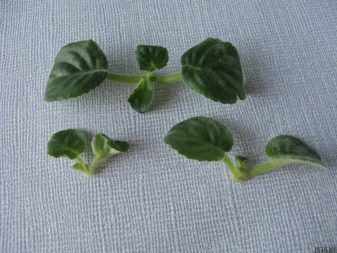
Leaf segments
The main rule when carrying out any manipulations with a plant is that the instrument must be sterilized and sharpened sharply. If there are traces of rot on the sheets, the blades should be wiped and disinfected after each procedure using alcohol or manganese.The incision line should not severely damage the lateral veins as much as possible. Each segment obtained from a leaf is capable of producing a baby - a rosette of leaves.
Consider the process of forming segments.
A central vein is cut from the leaf, the resulting halves are divided into three parts, while maintaining the lateral veins (lines extending from the central vein to the edges of the leaf). A fragment from the top of the leaf has a higher chance of rooting. A daughter socket is in any case formed from each received segment.


Another way is to cut the sheet in half. The upper and lower fragments are placed in the ready-made earthen mixture. If rotting occurs on the cuttings, it is necessary to remove the infected areas to healthy tissues, trying to preserve the veins.
After forming the segments, each piece of the leaf is left in air at room temperature for 20 minutes. The sections should dry out and be covered with a film, only after that the fragment is planted in the substrate, followed by processing in a solution of potassium permanganate.
Potassium permanganate is diluted in water, leaf segments are lowered into this liquid in turn for 15 minutes, after the procedure, the sections are treated with activated carbon. This method is designed to minimize the risks of fungal and other diseases during the formation of the root system of the future plant, accelerating the process of root growth.
After processing the slices, the leaves dry out in natural conditions, then they are placed in prepared containers under the greenhouse. Brick chips, foam balls, broken tiles and so on are suitable for drainage.
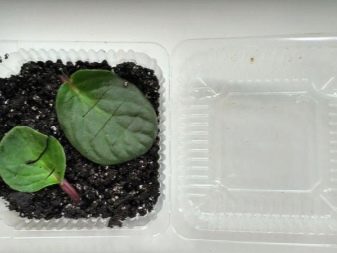
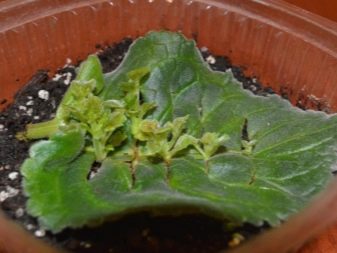
With the help of peduncles
For growing a new plant, peduncles of the mother culture are suitable. Fresh, young, dense flower stalks filled with juice, without defects, rot and other flaws are selected for the procedure. On the selected segment, all flowers and ovaries are removed, the peduncle stem is shortened to 1 cm, processes with buds - up to 5 mm, the first pair of leaves is cut off half the length.
A prepared container of a small volume is filled with a substrate. The stalk is air-dried for half an hour. The soil is spilled with clean water, a small hole is dug in the center. The cutting is deepened into the planting zone at the level of the leaves (the leaf plates should touch the soil mixture or be slightly immersed in it).
The pot is placed in a greenhouse environment. A month and a half later, a new outlet is formed. As the plant develops, flower ovaries will form, which must be removed. After about 3 months, the plant will be ready to be transplanted into a permanent pot.

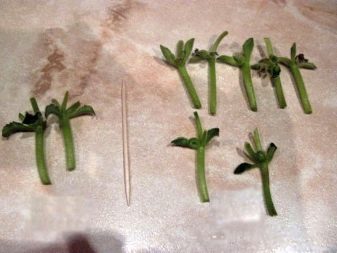
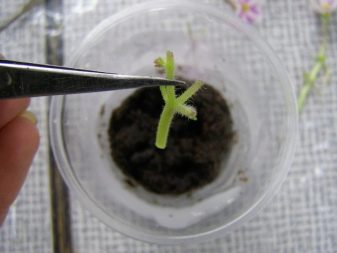
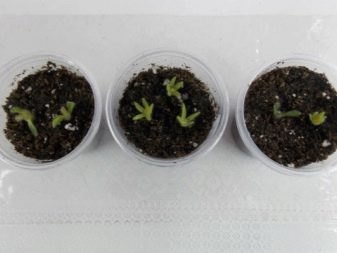
Necessary conditions for growing
To facilitate the process of rooting new Saintpaulia it is worth following the recommendations of specialists.
- Young violets should be grown in a loose, nutritious, moisture-absorbing substrate that is able to pass air.
- The optimum temperature for growing cuttings is +22.26 degrees.
- During the entire period of adaptation and rooting, the soil must be regularly and evenly moistened.
- Daylight hours for a flower is 12 hours. With the help of a phyto-lamp, you can compensate for the number of hours of short daylight hours.
- Each stalk must be planted in separate containers of small volume. Suitable cups with a volume of 50 ml, planting pots for seedlings. Make a hole at the bottom of each container to remove excess moisture and reduce the risk of water stagnation and root decay.
- Each sprout should be covered with a plastic bag, or made a mini-greenhouse - a young plant needs moist air. As the root system develops, the time for airing the greenhouse will increase. The time spent in such a system depends on the condition of the sprout - on average, this period takes 7-10 days. Every day the airing time increases by 10-15 minutes.
- The soil mixture consists of vermiculite or perlite, sod land, sphagnum moss, sand.
- Young plants should be protected from drafts and sudden temperature changes.
- Top dressing of crops occurs only after transplanting into a permanent container after 2-3 months.
If necessary, the plant is sprayed with Epin. This substance is used as a growth stimulant, fortifying agent.
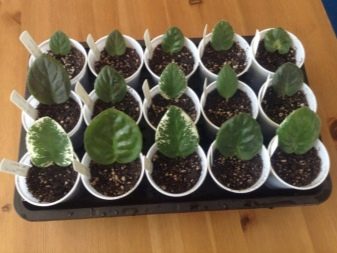
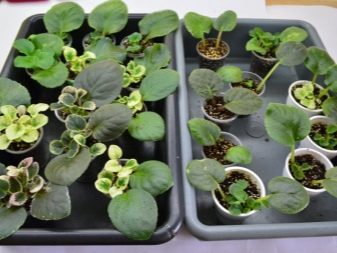
For the propagation of violets by a leaf, see the next video.































The comment was sent successfully.